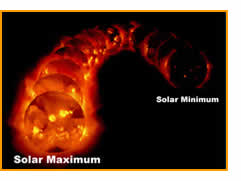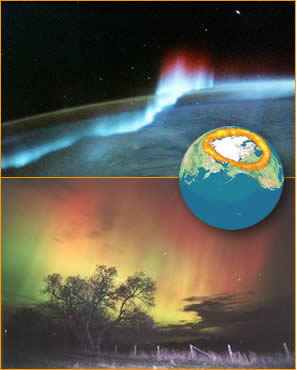


Space Weather Forecasting
Fighter pilots begin each day by checking the weather. Maybe you check the weather to decide what to wear. Fighter pilots check the weather because their lives depend upon it. You might check the temperature and precipitation. Pilots check for air pressure changes, storm fronts, precipitation, wind speeds, cloud density and altitude, and jet streams.
Scientists at NASA also check the weather because the astronauts’ lives depend upon it. They check "space weather" forecasts. The National Oceanic Atmospheric Administration’s Space Environment Center (NOAA/SEC) in Boulder, Colorado, provides NASA with solar forecasts every day at 10 AM. The SEC counts and monitors sunspots, coronal flares, solar wind speeds, and the production of X-rays, gamma rays, radio waves, and microwaves.
Solar Weather Watch Bulletin: Jan 17-24, 2001. Along with higher-than-normal solar weather activity, the sun has unleashed a series of significant solar flares. A spike of X-ray energy originated late January 17th from a sunspot group located in active region 1287. First observed last week, the group appears to be shifting. However, it could unleash additional turbulence before it rotates behind the sun next week. "The active region’s sunspots are growing in complexity. Additional satellite-endangering solar activity could erupt within the next month," observes NOAA/SEC senior forecaster Mark Billtagh.
The sunspot described in this weather report was eleven times the size of the earth. The storm erupting from this active region was one of the strongest in recorded history.
Space Weather
The sun produces a vast number of constantly changing
magnetic fields. Many are specifically associated with sunspots and other
active solar regions. The sun’s thermonuclear core, its shifting
plasma, widely varying temperature zones, and uneven rotation causes magnetic
fields within the sun to twist, snap, and erupt above the surface. Charged
particles, attracted to the oppositely charged magnetic field lines produce
amazing looping displays of light, especially when viewed through coronagraphs
and X-ray telescopes mounted on satellites. During such "magnetic"
eruptions, solar matter is fired into space and may move in the direction
of earth and the space station.
Approximately every 11 years, the sun goes through a cycle in which the number of sunspots, flares, and solar storms produced by the sun rises and falls. Data recently gathered from the SOHO satellite suggests that the North and South poles of the sun actually flip-flop, changing places and creating huge amounts of solar activity. When this activity peaks, the sun is at its solar maximum.
 Space
Weather on Earth
Space
Weather on Earth
During solar maximum, the sun produces a great
many solar flares. These giant eruptions of magnetism, electromagnetic
waves and charged particles on the sun’s surface are comparable to
the explosion of a hundred million hydrogen bombs. A major flare, called
a coronal mass ejection, emits X-rays that travel through space at the
speed of light. X-rays are followed by a wave of protons (ionized hydrogen
atoms), ionized helium atoms, and other radioactive particles, all of
which makes up what scientists call "solar plasma." This solar
plasma traveling in the vacuum of space comprises the "solar wind."
Extreme coronal mass ejections, called solar proton events, have been known to induce electrical currents above the earth. On several occasions this electrical phenomena has interfered with electric power transmission equipment in northern Canada. Such events have also caused the failure of dozens of navigation and communications satellites over the years.
Earth's Natural Protection
On earth, we are relatively safe from harmful
solar radioactivity. Solar X-rays and radioactive particles are blocked
or de-energized before they reach the earth's surface by the Van Allen
Belts. The Van Allen Belts, doughnut-shaped belts full of ionized gases
that encircle the earth, serve as a buffer zone between the earth and
the sun. They help to trap high-energy particles shot into space by solar
flares.
Solar protons and other radioactive particles also
interact with the earth’s magnetosphere. The earth's magnetic field
lines act like electric wires. As the charged particles from the sun cross
the magnetic field lines, the particles spiral around and travel down
the lines toward the earth’s North and South Poles. Upon entering
the ionosphere, some of the particles collide with gas molecules. This
creates the spectacular light displays known as the aurora borealis
(northern lights) and the aurora australis (southern lights).
 |
 |
The interaction of the solar particles and earth's magnetic field tends to act like an electric power generator and can produce what some scientists estimate to be almost 100,000 volts of electricity. This "power-generator" creates its own magnetic field, which, along with the Earth’s magnetic field, forms an electric "power grid" that distributes electricity throughout the Earth's upper atmosphere. On the surface of the earth, we are safe from this high-powered, electric grid. Our communications satellites, however, and our earth-bound power plants can be affected by these high-altitude power surges.
Although humans are not directly affected by solar flares, some animals may also experience temporary physical malfunctions. Pigeons, dolphins, whales, and other migratory animals have internal biological compasses composed of magnetite that is wrapped in bundles of nerve cells in their heads. The electrical and magnetic fields produced during geomagnetic storms interfere with the animal’s compasses and disable their navigational systems. At times, NOAA/SEC may provide space weather forecasts to homing pigeon farmers who are worried about their pigeons’ ability to return home.
How We Know
Satellites gather space weather data. One satellite,
totally dedicated to monitoring the sun, the Solar and Heliospheric Observatory,
or SOHO satellite, orbits between the earth and the sun year-round. Unaffected
by the atmosphere, this satellite plays a critical role in predicting
and measuring solar activity and solar storms. Its sensitive equipment
measures the solar wind speed, the density of solar protons, X-ray intensity,
and other vital solar weather indicators. Early satellite warnings of
solar storms permit us to take the steps required to protect earth-bound
electric power grids, communications and navigation systems, homing pigeons,
and the astronauts orbiting in harm’s way far above the earth’s
surface.
